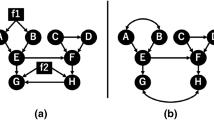Abstract
We address the problems of causal structure inference from conditional independence facts when latent confounders are admitted. The conditions that allow one to identify latent confounders and fully or partially recognize causal links are described. The updated implicative rules for orienting edges under confounding are suggested. We propose several new rules that are able to reveal bows and confounded causal edges. The rules rely on facts of absence of certain authentic edges (edge absence may be implied by Verma constraint or given in input as a priori requirement).
Similar content being viewed by others
References
J. Pearl, Causality: Models, Reasoning, and Inference, Cambridge Univ. Press, Cambridge (2000).
P. Spirtes, C. Glymour, and R. Scheines, Causation, Prediction and Sebowh, MIT Press, New York (2001).
T. Verma and J. Pearl, “Causal networks: Semantics and expressiveness,” in: Proc. of the 4th Annual Conf. on Uncertainty in Artificial Intelligence (UAI) (1988), pp. 352–359. https://doi.org/10.48550/ar**v.1304.2379.
P. Spirtes, C. Meek, and T. Richardson, “An algorithm for causal inference in the presence of latent variables and selection bias,” in: C. Glymour and G. F. Cooper (eds.), Computation, Causation, and Discovery, AAAI Press, Menlo Park, CA (1999), pp. 211–252. https://doi.org/10.7551/mitpress/2006.003.0009.
J. Zhang, “On the completeness of orientation rules for causal discovery in the presence of latent confounders and selection bias,” Artif. Intell., Vol. 172, Iss. 16–17, 1873–1896 (2008). https://doi.org/10.1016/j.artint.2008.08.001.
D. Colombo and M. H. Maathuis, “Order-independent constraint-based causal structure learning,” J. Mach. Learn. Res. 2014. Vol. 15. P. 3921–3962.
C. Meek, “Causal inference and causal explanation with background knowledge,” in: P. Besnard and S. Hanks (eds.), Proc. of the 11th Conf. on Uncertainty in Artificial Intelligence, Morgan Kaufmann Publ., San Mateo (1995), pp. 403–410.
I. Shpitser, R. J. Evans, T. S. Richardson, and J. M. Robins, “Introduction to nested Markov models,” Behaviormetrika, Vol. 41, No. 1, 3–39 (2014) https://doi.org/10.2333/bhmk.41.3.
R. Bhattacharya, T. Nagarajan, D. Malinsky, and I. Shpitser, “Differentiable causal discovery under unmeasured confounding,” in: Proc. of the 24th Intern. Conf. on Artificial Intelligence and Statistics, PMLR, Vol. 130, 2314–2322 (2021).
T. Richardson and P. Spirtes, “Ancestral graph Markov models,” Ann. Statist., Vol. 30, No. 4, 962–1030 (2002). https://doi.org/10.1214/aos/1031689015.
O. S. Balabanov, “Logic of minimal separation in causal networks,” Cyber. Syst. Analysis, Vol. 49, No. 2, 191–200 (2013). https://doi.org/10.1007/s10559-013-9499-y.
O. S. Balabanov, “Acceleration of inductive inference of causal diagram,” Revised Jan (2013). (preprint at ResebowhGate). URL: https://www.resebowhgate.net/publication/324160860_Acceleration_of_Inductive_Inference_of_Causal_Diagrams_Proc_of_the_4th_Intern_Workshop_on_Inductive_Modelling_IWIM’2011_-_Kyiv_July_4-11_2011_-_P_16-21_-_ISBN_978-966-02-6078-8_Revised_2013.
C. Uhler, G. Raskutti, P. Bühlmann, and B. Yu, “Geometry of the faithfulness assumption in causal inference,” Ann. Statist., Vol. 41, No. 2, 436–463 (2013). https://doi.org/10.1214/12-AOS1080.
O. S. Balabanov, “Logic of causal inference from data under presence of latent confounders,” Cybern. Syst. Analysis, 58, No. 2, 171–185 (2022). https://doi.org/10.1007/s10559-022-00448-z.
O.S. Balabanov, “Causal inference from data under presence of latent confounders. Some inadequacy problems (revised)”. 18 p. (2021). https://www.researchgate.net/publication/352647034_CAUSAL_INFERENCE_FROM_DATA_UNDER_PRESENCE_OF_LATENT_CONFOUNDERS_SOME_INADEQUACY_PROBLEMS_revised_in_Ukrainian#fullTextFileContent.
J. Tian and J. Pearl, “On the testable implications of causal models with hidden variables,” in: A. Darwiche and N. Friedman (eds.), Uncertainty in Artificial Intelligence: Proc. 18th Conf., Morgan Kaufmann Publ., San Francisco (2002), pp. 519–527.
I. Shpitser, T. Richardson, and J. Robins, “Testing edges by truncations,” in: Proc. 21st Intern. Joint Conf. on Artificial Intelligence (IJCAI 2009), Vol. 21, Pasadena, California (2009), pp. 1957–1963.
J. M. Robins, “Testing and estimation of direct effects by reparameterizing directed acyclic graphs with structural nested models,” in: C. Glymour and G. Cooper (eds.), Computation, Causation, and Discovery, AAAI Press, Menlo Park, CA (1999), pp. 349–405.
Author information
Authors and Affiliations
Corresponding author
Additional information
Translated from Kibernetyka ta Systemnyi Analiz, No. 3, May–June, 2024, pp. 26–44; https://doi.org/10.34229/KCA2522-9664.24.3.3.
Rights and permissions
Springer Nature or its licensor (e.g. a society or other partner) holds exclusive rights to this article under a publishing agreement with the author(s) or other rightsholder(s); author self-archiving of the accepted manuscript version of this article is solely governed by the terms of such publishing agreement and applicable law.
About this article
Cite this article
Balabanov, O.S. Causal Discovery from Markov Properties Under Latent Confounders. Cybern Syst Anal 60, 359–374 (2024). https://doi.org/10.1007/s10559-024-00677-4
Received:
Published:
Issue Date:
DOI: https://doi.org/10.1007/s10559-024-00677-4




